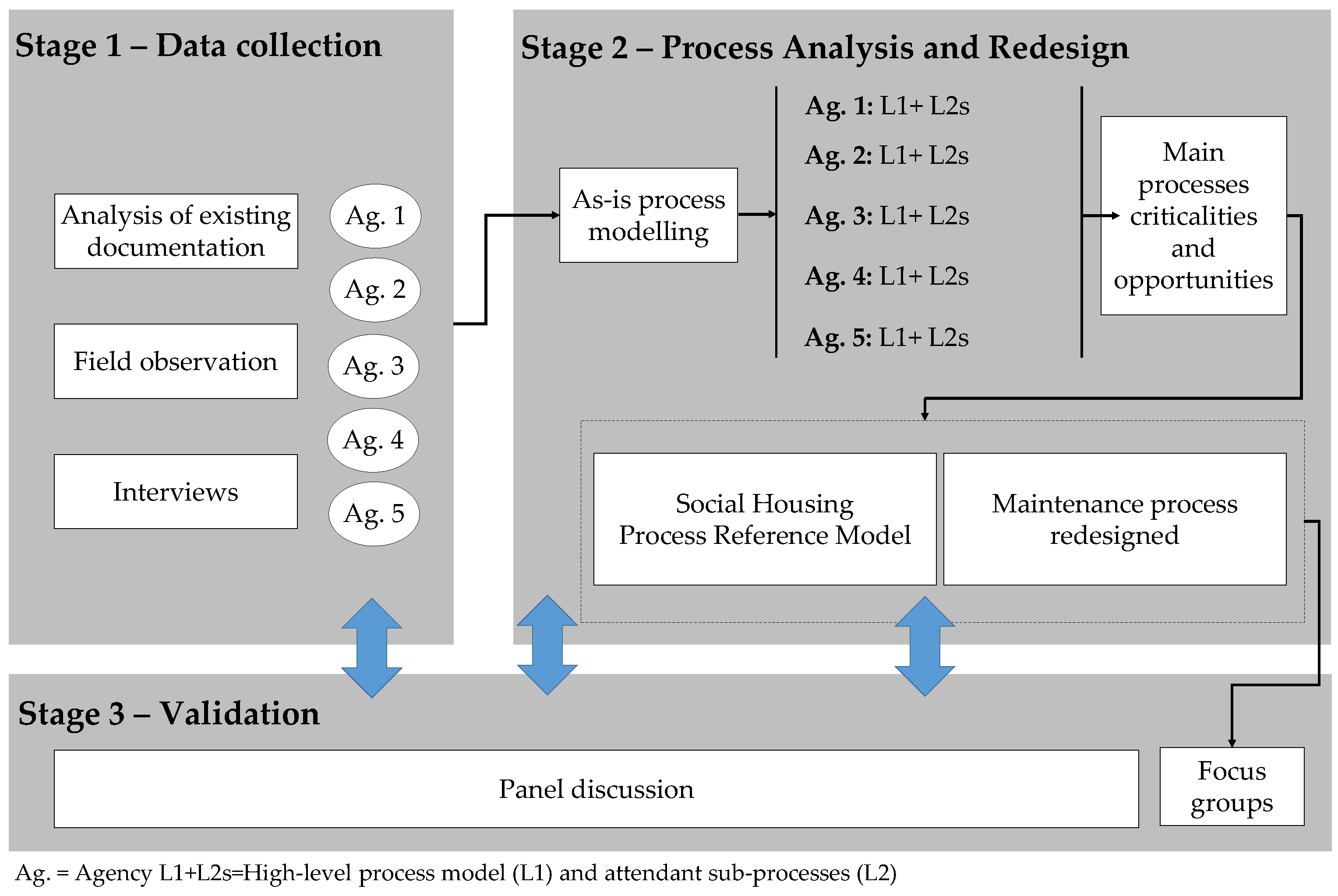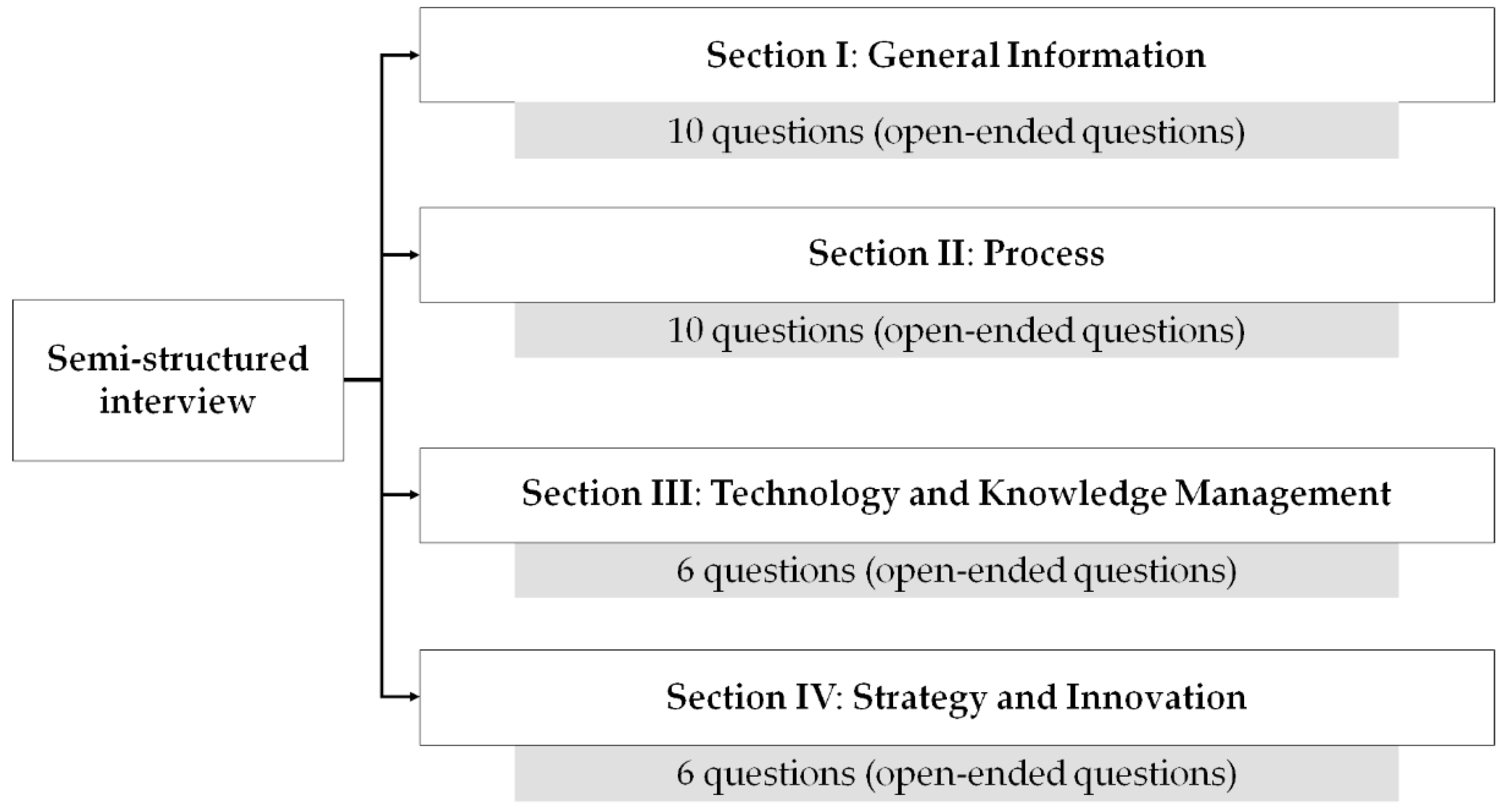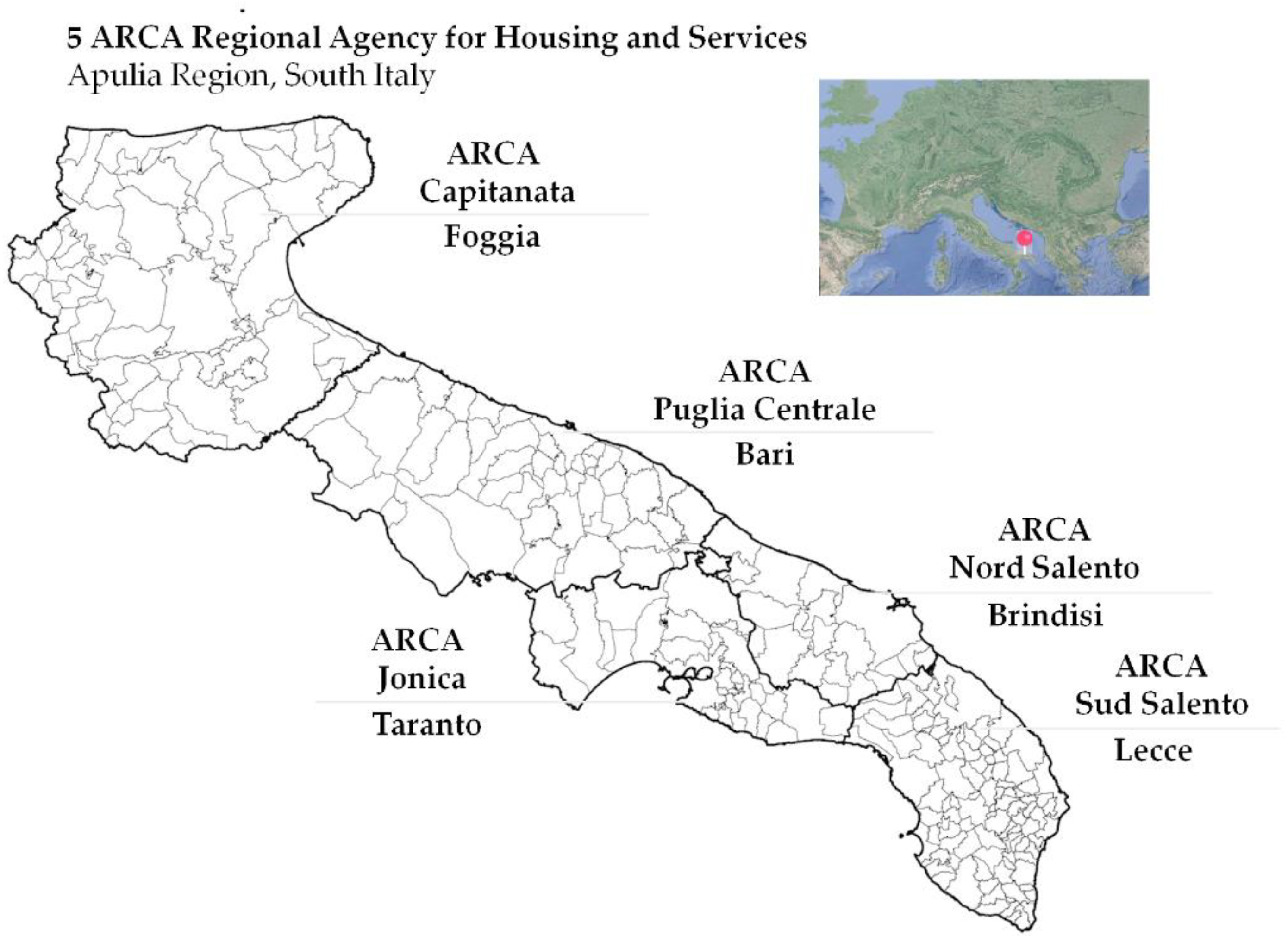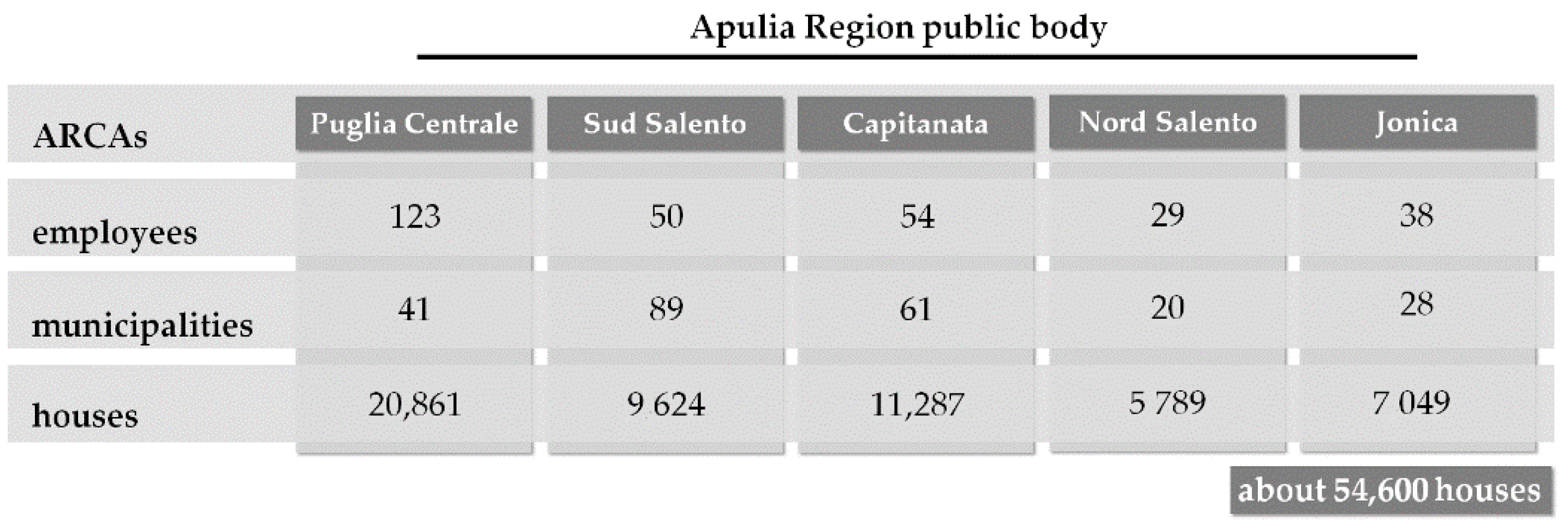Process View to Innovate the Management of the Social Housing System: A Multiple Case Study
Abstract
:1. Introduction
2. Background
2.1. Process Theory and Business Process Management
2.2. Social Housing and Process Management
3. Research Design
- Stage 1.
- Data collection (analysis of existing documentation, field observation, and interviews with process actors);
- Stage 2.
- Process analysis (as-is process analysis and modelling, identification of process criticalities) and redesign of the maintenance process to address process criticalities and seize opportunities in accordance with ambidextrous BPM;
- Stage 3.
- Validation (panel discussion and focus groups to get feedback and insights on the study).
3.1. Data Collection
- -
- Regional and National Legislation (common to all the five Agencies).
- -
- “Carte dei Servizi” (Services Charter) and “Statuto” (Statute).
- -
- “Bilancio Sociale” (Sustainability Report) and “Annual Report”, which describe the work carried out, human resources, strategic vision, collaboration, and active network.
- -
- Documentation and descriptions reported on the official website.
- -
- Asset information.
3.2. Process Analysis, Redesign and Standardization
3.3. Validation
4. Multiple Case Study
5. Results
5.1. As-Is Process Models
5.2. “Problematic” Situation
5.3. To-Be Process Model for the Maintenance Process
- -
- involves several players of the AEC/FM supply chain, e.g., construction companies, suppliers, designers, Region, Municipalities, citizens;
- -
- has the longest duration, compared to the entire building lifecycle;
- -
- is characterized by multiple instances that repeat over time for a specific building;
- -
- is deficient in information support (as all the other processes);
- -
- requires huge economic resources, more than those required by other processes.
5.4. Validation Outcome
6. Discussion
- (1)
- the adoption of process theory combined with ambidextrous business process management is an underexplored research method in the field of AEC/FM research. The results reported in the study reaffirm the potential deriving from its adoption also in such a field;
- (2)
- the process view can be used as a vehicle to innovate the social housing system that could prove crucial to facilitate innovation and the digital transformation of public administrations. All innovation interventions need, indeed, to be framed into an integrated “program-process” able to provide an overall vision on what is carried out in the organization;
- (3)
- the analysis and redesign of processes should be carried out together with the process actors and main stakeholders. The involvement of process actors is essential to develop “feasible and desirable” solutions and successfully implement technological innovations.
7. Conclusions
Author Contributions
Funding
Institutional Review Board Statement
Informed Consent Statement
Data Availability Statement
Acknowledgments
Conflicts of Interest
Appendix A. Social Housing Process Reference Model
Appendix B. Maintenance Process Redesigned
References
- Rotmans, J.; Van Asselt, M. Towards an integrated approach for sustainable city planning. J. Multi-Criteria Decis. Anal. 2000, 9, 110–124. [Google Scholar] [CrossRef]
- Von der Leyen, U. A Union That Strives for More My Agenda for Europe. Political Guidelines for the Next European Commission 2019–2024. 2019. Available online: https://ec.europa.eu/commission/sites/beta-political/files/political-guidelines-next-commission_en.pdf (accessed on 9 July 2020).
- European Commission. The European Construction Sector: A Global Partner. Internal Market, Industry, Entrepreneurship and SMEs Directorate General Energy Directorate General Joint Research Centre (JRC). 2016. Available online: https://ec.europa.eu/docsroom/documents/4721/attachments/1/translations/en/renditions/native (accessed on 7 July 2021).
- Housing Europe. Better EU Rules for better Services of General Interest in Housing. Housing Europe Letter to Commissioner for Competition, Margrethe Vestager. Economy, Future of the EU & Housing. 2016. Available online: https://www.housingeurope.eu/resource-657/better-eu-rules-for-better-services-of-general-interest-in-housing (accessed on 7 July 2020).
- United Nations. Universal Declaration of Human Rights (UDHR). 1948. Available online: https://www.un.org/sites/un2.un.org/files/udhr.pdf (accessed on 6 July 2020).
- Tagliabue, L.C.; Buzzetti, M.; Manfren, M. Social housing retrofit towards energy efficiency thresholds extensible on social housing in Italy. In Proceedings of the International Conference on Clean Electrical Power (ICCEP), Alghero, Italy, 11–13 June 2013; pp. 717–723. [Google Scholar]
- Oyebanji, A.O. Development of a Framework for Sustainable Social Housing Provision (SSHP) in England. Ph.D. Thesis, University of Central Lancashire, Preston, UK, 2014. [Google Scholar]
- Carswell, A.T. The Encyclopedia of Housing; Sage: New York, NY, USA, 2012; Volume 1. [Google Scholar]
- Housing Europe. Country Profile. Social Housing in Europe, Italy. 2010. Available online: http://www.housingeurope.eu/resource-111/social-housing-in-europe (accessed on 6 July 2020).
- HABITAT. Glossary of the HABITAT III—Preparatory Process and the Conference; HABITAT III; United Nations: New York, NY, USA, 2016. [Google Scholar]
- Blaso, L.; Clemente, P.; Giovinazzi, S.; Giuliani, G.; Gozo, N.; Ormando, C.; Pollino, M.; Rosato, V. Towards Standardized and Interoperable Platforms for Supporting the Seismic Vulnerability Assessment and Seismic Monitoring of Italian Bridges and Viaducts. In International Conference of the European Association on Quality Control of Bridges and Structures; Springer: Cham, Switzerland, 2021; pp. 471–480. [Google Scholar]
- Housing Europe. The State of Housing in Europe 2021. 2021. Available online: https://www.stateofhousing.eu/#p=1 (accessed on 6 December 2021).
- Colglazier, W. Sustainable development agenda: 2030. Science 2015, 349, 1048–1050. [Google Scholar] [CrossRef] [PubMed]
- Tosi, A. Le Case dei Poveri: È Ancora Possibile Pensare un Welfare Abitativo? Mimesis: Sesto San Giovanni, Italy, 2017. [Google Scholar]
- Pawson, H.; Lawson, J.; Milligan, V. Social Housing Strategies, Financing Mechanisms and Outcomes: An International Review and Update of Key Post-2007 Policy Developments; City Futures Research Centre: Sydney, Australia, 2011. [Google Scholar]
- Calavita, N.; Mallach, A. (Eds.) Inclusionary Housing in International Perspective: Affordable Housing, Social Inclusion, and Land Value Recapture; Lincoln Institute of Land Policy: Cambridge, MA, USA, 2015. [Google Scholar]
- Capurso, L.; Gagliardi, A. 100 anni di IACP Bari. 1906–2006. In Il Centenariato Dello IACP di Bari tra Passato e Future; Edizioni Giuseppe Laterza: Bari, Italy, 2006. [Google Scholar]
- Chen, W.; Chen, K.; Cheng, J.C.; Wang, Q.; Gan, V.J. BIM-based framework for automatic scheduling of facility maintenance work orders. Autom. Constr. 2018, 91, 15–30. [Google Scholar] [CrossRef]
- Johnson, J. Cities: Systems of systems of systems. In Complexity Theories of Cities Have Come of Age; Springer: Berlin/Heidelberg, Germany, 2012; pp. 153–172. [Google Scholar]
- Rochet, C. Urban Lifecycle Management: System architecture applied to the conception and monitoring if smart cities: What Consequences for Public Management? In Complex Systems Design & Management; Springer: Cham, Switzerland, 2015; pp. 259–271. [Google Scholar]
- Checkland, P. Achieving feasible desirable changes: An application of Soft System Methodology. J. Oper. Res. Soc. 1985, 36, 821–831. [Google Scholar]
- Mohr, L.B. Explaining Organizational Behavior: The Limits and Possibilities of Theory and Research; Jossey-Bass: San Francisco, CA, USA, 1982. [Google Scholar]
- Kohlborn, T.; Mueller, O.; Poeppelbuss, J.; Roeglinger, M. Interview with Michael Rosemann on ambidextrous business process management. Bus. Process Manag. J. 2014, 20, 634–638. [Google Scholar] [CrossRef]
- Markus, L.M.; Robey, R. Information Technology and Organizational Change: Causal Structure in Theory and Research. Manag. Sci. 1988, 34, 583–598. [Google Scholar] [CrossRef]
- Corallo, A.; Latino, M.E.; Menegoli, M. A business process modelling approach for supporting traceability in food industry. In Proceedings of the 8th International Conference on Industrial Technology and Management (ICITM), Cambridge, UK, 2–4 March 2019; pp. 265–269. [Google Scholar]
- Crowston, K. A coordination theory approach to organizational process design. Organ. Sci. 1997, 8, 157–175. [Google Scholar] [CrossRef]
- Langley, A. Studying processes in and around organizations. In Sage Handbook of Organizational Research Methods; Buchanan, D., Bryman, A., Eds.; Sage Publications: London, UK, 2009; pp. 409–429. [Google Scholar]
- Pentland, B.T. Information systems and organizational learning: The social epistemology of organizational knowledge systems. Account. Manag. Inf. Technol. 1995, 5, 1–21. [Google Scholar] [CrossRef]
- Van de Ven, A.H.; Poole, M.S. Methods for studying innovation development in the Minnesota Innovation Research Program. Organ. Sci. 1990, 1, 313–335. [Google Scholar] [CrossRef]
- Dumas, M.; La Rosa, M.; Mendling, J.; Reijers, H.A. Fundamentals of Business Process Management; Springer: Berlino, Germania, 2013. [Google Scholar]
- Vom Brocke, J.; Rosemann, M. (Eds.) Handbook on Business Process Management 2; Springer: Berlin, Germany, 2010. [Google Scholar]
- Vom Brocke, J.; Zelt, S.; Schmiedel, T. On the role of context in business process management. Int. J. Inf. Manag. 2016, 36, 486–495. [Google Scholar] [CrossRef]
- Hofman, W.; Lohman, W.; Schelling, A. A flexible IT infrastructure for integrated urban planning. J. Theor. Appl. Electron. Commer. Res. 2011, 6, 16–25. [Google Scholar] [CrossRef] [Green Version]
- Innes, J.E.; Booher, D.E. Consensus building and complex adaptive systems: A framework for evaluating collaborative planning. J. Am. Plan. Assoc. 1999, 65, 412–423. [Google Scholar] [CrossRef]
- Cassa Depositi e Prestiti. Social Housing. In Il Mercato Immobiliare in Italia: Focus Sull’edilizia Sociale; CDP: Rome, Italy, 2014. [Google Scholar]
- Dioguardi, G. Per una Scienza Nuova del Governo Della Città; Donzelli Editore: Roma, Italy, 2017. [Google Scholar]
- Hammer, M.; Stanton, S. How process enterprises really work. Harv. Bus. Rev. 1999, 77, 108–120. [Google Scholar] [PubMed]
- Becker, J.; Algermissen, L.; Falk, T. Modernizing Processes in Public Administrations; Springer: Berlin/Heidelberg, Germany, 2012. [Google Scholar]
- Torres, V.; Giner, P.; Bonet, B.; Pelechano, V. Adapting BPMN to public administration. In International Workshop on Business Process Modeling Notation; Springer: Berlin/Heidelberg, Germany, 2010; pp. 114–120. [Google Scholar]
- Zwicker, J.; Fettke, P.; Loos, P. Business Process Maturity in Public Administrations. In Handbook on Business Process Management 2; vom Brocke, J., Rosemann, M., Eds.; Springer: Berlin/Heidelberg, Germany, 2010. [Google Scholar]
- Anderson, S.D.; Patil, S.S.; Gibson, G.E., Jr.; Sullivan, G.R. Owner–contractor work structures: Process approach. J. Constr. Eng. Manag. 2004, 130, 680–690. [Google Scholar] [CrossRef]
- Cheng, M.Y.; Tsai, M.H. Reengineering of construction management process. J. Constr. Eng. Manag. 2003, 129, 105–114. [Google Scholar] [CrossRef]
- Costa, L.; Barbosa, M.B.A.; Baldam, R.D.L.; Coelho, T.D.P., Jr. Challenges of Process Modeling in Architecture and Engineering to Execute Projects and Public Works. J. Constr. Eng. Manag. 2019, 145, 05018015. [Google Scholar] [CrossRef]
- Di Biccari, C.; Lazoi, M.; Malagnino, A.; Mangialardi, G.; Romano, T. Living Lab as enabler of new technologies in Public Administrations: The B@ARCA project. In Proceedings of the 2020 IEEE International Conference on Engineering, Technology and Innovation (ICE/ITMC), Cardiff, UK, 15–17 June 2020; pp. 1–11. [Google Scholar]
- BuildingSmar. BuildingSmart International. 2018. Available online: https://www.buildingsmart.org/ (accessed on 7 June 2020).
- IDM Technical Team. Quick Guide Business Process Modeling Notation (BPMN). 2007. Available online: https://standards.buildingsmart.org/documents/IDM/IDM_guide-QuickGuideToBPMN-2007_01.pdf (accessed on 7 June 2020).
- Diván, M.; Reynoso, M.L.S.; Veralli, F.; Ostoich, M. Experiences in the Business Process Modelling at Public Organisms of La Pampa. In Proceedings of the 6th International Conference on Reliability, Infocom Technologies and Optimization (Trends and Future Directions) (ICRITO), Noida, India, 20–22 September 2017; pp. 326–332. [Google Scholar]
- Kassela, K.; Papalexi, M.; Bamford, D. Applying quality function deployment to social housing? TQM J. 2017, 29, 422–437. [Google Scholar] [CrossRef]
- Leblanc, H.; Thomson, C.; Cameron, I.; Nitithamyong, P. Developing a planned work process model for housing associations. Eng. Constr. Archit. Manag. 2013, 20, 232–249. [Google Scholar] [CrossRef]
- Oliva, C.A.; Granja, A.D. An investigation into collaborative practices in social housing projects as a precondition for target value design adoption. In Proceedings of the 21th Annual Conference of the International Group for Lean Construction, Fortaleza, Brazil, July 29–2 August 2013; pp. 429–437. [Google Scholar]
- Salazar, N.R.; Heyl, B.H. Integration and Implementation of an EA strategy based operating model with BPM technology—Case Study: Housing credit process, Banco Estado Ecuador. In Proceedings of the 34th International Conference of the Chilean Computer Science Society (SCCC), Santiago, Chile, 9–13 November 2015; pp. 1–8. [Google Scholar]
- Webb, M.D.; Rohe, W.M.; Nguyen, M.T.; Frescoln, K.; Donegan, M.; Han, H.S. Finding HOPE: Changes in depressive symptomology following relocation from distressed public housing. Soc. Sci. Med. 2017, 190, 165–173. [Google Scholar] [CrossRef]
- Yin, R.K. Case Study Research Design and Methods: Applied Social Research and Methods Series; Sage Publications: Thousand Oaks, CA, USA, 1994. [Google Scholar]
- Ceci, F.; Iubatti, D. Personal relationships and innovation diffusion in SME networks: A content analysis approach. Res. Policy 2012, 41, 565–579. [Google Scholar] [CrossRef]
- Kaschig, A.; Maier, R.; Sandow, A.; Lazoi, M.; Schmidt, A.; Barnes, S.A.; Mazarakis, A. Organizational learning from the perspective of knowledge maturing activities. IEEE Trans. Learn. Technol. 2013, 6, 158–176. [Google Scholar] [CrossRef]
- BPTrends. BPTrends. BPM Analysis, Opinion and Insight. 2013. Available online: https://www.bptrends.com/resources/glossary/scope-diagram-or-input-guides-outputs-enablers-igoe-diagram/ (accessed on 6 June 2020).
- Tuomi, I. Data is more than knowledge: Implications of the reversed knowledge hierarchy for knowledge management and organizational memory. In Proceedings of the 32nd Annual Hawaii International Conference on Systems Sciences, HICSS-32, Maui, HI, USA, 5–8 January 1999; pp. 1–22. [Google Scholar]
- Bell, E.; Bryman, A.; Harley, B. Business Research Methods; Oxford University Press: Oxford, UK, 2018. [Google Scholar]
- Beutel, T.; Jonas, J.M.; Moeslein, K.M. Co-creation and user involvement in a living lab: An evaluation of applied methods. In Proceedings of the 13th International Conference on Wirtschaftsinformatik, St. Gallen, Switzerland, 12–15 February 2017; pp. 1453–1464. [Google Scholar]
- Sudha, C. Rational Prescriptions for the Private Health Sector—Panel Discussion, 28 March 2015, Bangalore. Available online: https://www.youtube.com/watch?v=g7OEY0uWzQ4 (accessed on 9 July 2020).
- Hennink, M.M. Focus Group Discussions; Oxford University Press: Oxford, UK, 2014. [Google Scholar]
- Sanchez, R.; Heene, A. (Eds.) Strategic Learning and Knowledge Management; Wiley: New York, NY, USA, 1997. [Google Scholar]
- Grieves, M. Product Lifecycle Management: Driving the Next Generation of Lean Thinking; McGraw-Hill: New York, NY, USA, 2006. [Google Scholar]
- Rosemann, M. Ambidextrous Business Process Management; Information Systems School Science and Engineering Faculty Queensland University of Technology Brisbane: Brisbane, Australia, 2013. [Google Scholar]
- Succar, B. Building information modelling maturity matrix. In Handbook of Research on Building Information Modeling and Construction Informatics: Concepts and Technologies; IGI Global: Hershey, PA, USA, 2010; pp. 65–103. [Google Scholar]
- Carmona, J.; Irwin, K. BIM: Who, What, How and Why. 2007. Available online: http://www.facilitiesnet.com/software/article/BIM-Who-What-How-and-Why--7546 (accessed on 9 July 2020).
- Papadonikolaki, E.; Wamelink, H. Inter-and intra-organizational conditions for supply chain integration with BIM. Build. Res. Inf. 2017, 45, 649–664. [Google Scholar] [CrossRef]
- Kolodner, J. Case-Based Reasoning; Morgan Kaufmann: Burlington, MA, USA, 2014. [Google Scholar]
- Sharp, M.; Jones, K. Perceived inefficiency in social housing maintenance. Constr. Innov. 2012, 12, 414–428. [Google Scholar] [CrossRef]
- Hitt, M.A.; Ireland, R.D.; Lee, H.U. Technological learning, knowledge management, firm growth and performance: An introductory essay. J. Eng. Technol. Manag. 2000, 17, 231–246. [Google Scholar] [CrossRef]
- Ho, J.Y.; O’Sullivan, E. Standardisation framework to enable complex technological innovations: The case of photovoltaic technology. J. Eng. Technol. Manag. 2018, 50, 2–23. [Google Scholar] [CrossRef]
- Gurevich, U.; Sacks, R.; Shrestha, P. BIM adoption by public facility agencies: Impacts on occupant value. Build. Res. Inf. 2017, 45, 610–630. [Google Scholar] [CrossRef]
- Alreshidi, E.; Mourshed, M.; Rezgui, Y. Cloud-based BIM governance platform requirements and specifications: Software engineering approach using BPMN and UML. J. Comput. Civ. Eng. 2015, 30, 04015063. [Google Scholar] [CrossRef] [Green Version]
- Parti, R.; Hauer, S.; Monsberger, M. Process model for BIM-based MEP design. In Proceedings of the IOP Conference Series, Earth and Environmental Science, Graz, Austria, 11–14 September 2019; IOP Publishing: Graz, Austria, 2019; Volume 323, pp. 1–8. [Google Scholar]
- European Commission. Industry 5.0: Towards More Sustainable, Resilient and Human-Centric Industry. 2021. Available online: https://ec.europa.eu/info/news/industry-50-towards-more-sustainable-resilient-and-human-centric-industry-2021-jan-07_en (accessed on 6 December 2021).
- Bellantuono, N.; Nuzzi, A.; Pontrandolfo, P.; Scozzi, B. Digital Transformation Models for the I4.0 Transition: Lessons from the Change Management Literature. Sustainability 2021, 13, 12941. [Google Scholar] [CrossRef]
- Houy, C.; Fettke, P.; Loos, P. Business process frameworks. In Handbook on Business Process Management 2; Springer: Berlin/Heidelberg, Germany, 2015. [Google Scholar]






| Technical Processes | Description |
|---|---|
| Work Planning | New building planning and/or works on existing buildings as well as the estimation of the time and cost of each intervention |
| Work Design (further decomposed into: New Construction, Definitive Design, and Executive Design) | Feasibility study, definitive and executive planning |
| Work Execution (further decomposed into: Tender, Work Supervision, Accounting, and Mandate Payment) | All the operations needed to carry out the planned works |
| Maintenance with ordinary funds (Self-Maintenance, Self-Management, and Emergency Maintenance) | Planned and unplanned maintenance |
| Periodic assessment of the assets’ conservation state | Survey activities to assess the state of conservation of the assets |
| Sale | Definition of sale agreements |
| Maintenance with extraordinary funds | Corrective maintenance with external funds |
| Demolition | Decision-making and planning for demolition of old and critical buildings |
| Reconstruction | Evaluation and planning for building reconstruction after demolition. |
| Administrative Processes | Description |
| Economic and Administrative Management | Administrative and economic management of the Agency regarding both fixed and asset-related costs |
| Assignment and Accommodation Delivery | Assignment procedures and delivery of housing to tenants |
| Asset Management | Rental management activities and related administrative procedures |
| Reassignment | Assignment procedures and delivery of housing to tenants after demolition works |
| Critical Issues |
|---|
| Lack of standardization of the work carried out by the Agencies - Workflows, tools and technologies, even vocabulary, are different from one Agency to another |
| Lack of an overall vision of the entire building lifecycle - Knowledge and information related to buildings is fragmented - Use of single employees’ personal spreadsheets to store pieces of information related to a building - Use of several non-integrated information systems and lack of a centralized database |
| Lack of coordination - Data and knowledge are not shared - Relevant communication is transferred only informally - Technical and administrative sectors work separately |
| Use of obsolete technology - Important documents are paper-based or stored in CD-ROMs so the retrieval of results is hard - Absence of any process automation |
| Inadequate procedures - Maintenance activities are carried out based on “emergency logic” |
| As-Is Processes—Critical Issue | As-Is Process Opportunities/Solutions | To-Be Proces |
|---|---|---|
Lack of standardization of the work carried out by the Agencies
|
| A standard to-be maintenance process for the five Agencies |
Lack of an overall vision of the entire building lifecycle
| Use of a shared Database BIM-based | |
Use of obsolete technology
| Use of a shared Database BIM-based Process redesigned exploiting BIM and Case- Based-Reasoning (CBR) | |
Lack of coordination
| Use of a shared Database BIM-based Creation of a high level process model Process redesigned based on BIM and CBR Adoption of a process view | |
Inadequate procedures
| Introduction of Preventive Maintenance also by means of CBR module |
Publisher’s Note: MDPI stays neutral with regard to jurisdictional claims in published maps and institutional affiliations. |
© 2022 by the authors. Licensee MDPI, Basel, Switzerland. This article is an open access article distributed under the terms and conditions of the Creative Commons Attribution (CC BY) license (https://creativecommons.org/licenses/by/4.0/).
Share and Cite
Mangialardi, G.; Corallo, A.; Lazoi, M.; Scozzi, B. Process View to Innovate the Management of the Social Housing System: A Multiple Case Study. Sustainability 2022, 14, 8294. https://doi.org/10.3390/su14148294
Mangialardi G, Corallo A, Lazoi M, Scozzi B. Process View to Innovate the Management of the Social Housing System: A Multiple Case Study. Sustainability. 2022; 14(14):8294. https://doi.org/10.3390/su14148294
Chicago/Turabian StyleMangialardi, Giovanna, Angelo Corallo, Mariangela Lazoi, and Barbara Scozzi. 2022. "Process View to Innovate the Management of the Social Housing System: A Multiple Case Study" Sustainability 14, no. 14: 8294. https://doi.org/10.3390/su14148294
APA StyleMangialardi, G., Corallo, A., Lazoi, M., & Scozzi, B. (2022). Process View to Innovate the Management of the Social Housing System: A Multiple Case Study. Sustainability, 14(14), 8294. https://doi.org/10.3390/su14148294







